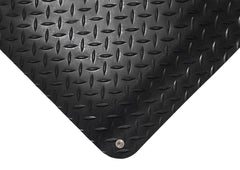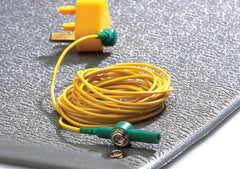- If using a workbench ESD mat, place the mat on top of the workbench and plug the grounding connector into a wall socket.
- If the mat is only equipped with an alligator clip, attach the clip from the mat to the computer that is being built or repaired. Make sure the computer is unplugged first!
- Attach the anti static strap to your wrist, with the alligator clip at the other end connected to the mat. You will now be able to work with your computer safely.

The process for anti-static floor mats is similar, except you will most likely be using a strap connected to your ankle rather than your wrist.
Anti-static mats are typically made from either Rubber or Vinyl. Rubber is the most widely used material for Anti Static mats as it has a high resistance to heat and chemicals, is durable and offers excellent comfort. Anti Static Rubber Mats are ideal for;
- Heat resistance – does not melt as easily
- Soldering areas
- Resistance to chemicals
- Resistance to cutting and abrasion
- Durability
Anti-static mats are either conducting or dissipative. Conductive mats can disperse static electricity quicker than dissipative mats can. This is because, with low electrical resistance, electrons flow easily across the mat's surface and, therefore, work faster than dissipative items. Dissipative items are slower as the charges flow to the ground more slowly because they have a higher surface resistance of more than 1 x 10 5 ohms. In contrast, conductive items have less than 1 x 10 5 ohms surface resistance.
Note: This guide is intended to provide general information about antistatic mats, their construction, features, and operation. It is the responsibility of the user to ensure that mats and associated equipment are used correctly and safely. As such, First Mats Ltd cannot accept liability for harm caused to people or components when using the information in this guide.









